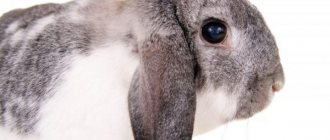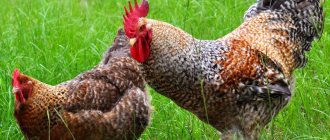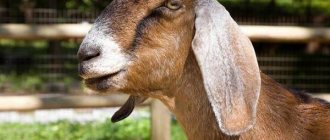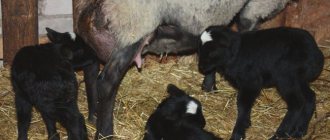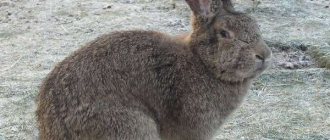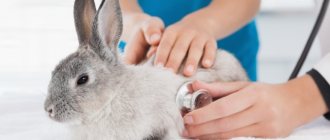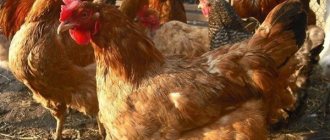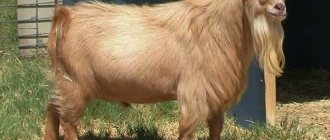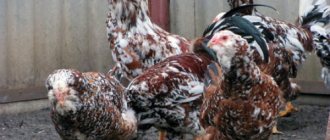Livestock » Rabbits
0
2245
Article rating
Kira Stoletova
In 1850, as a result of crossing the English Fold rabbit and the Flemish giant, scientists developed a new breed called the French Ram. The English Fold rabbit was bred through a natural mutation of the ear, which then became a characteristic feature of this breed. The Flemish giant, on the contrary, was large in size, which influenced the results of crossing the 2 representatives. The French Ram is a fairly large animal that quickly gains weight and is unpretentious to food and living conditions.
Rabbit breed French Ram
An adult representative of the genus reaches 4-8 kg, is famous for its shiny, smooth coat, and has an unusual ear shape.
Fold rabbits rapidly gained popularity, and in 1870 they became known throughout Europe. The countries of the European Union have gained popularity thanks to the breeding of several types of French Rams.
Folds were once considered exotic animals, thanks to their floppy ears and round, massive head. Currently, anyone can keep these animals. The French Ram is a rabbit that looks very cute both in photos and in real life.
History of origin
The breed was developed in France in the mid-19th century. Her parents were representatives of the Flemish Giant and English Fold breeds.
The result was animals with a bright appearance, as well as excellent productive qualities, all of which helped them gain appreciation and wide distribution in European countries such as Germany, the Netherlands, and Belgium. These countries subsequently became the place where the breed standard was established.
Important! A small rabbit of this breed's ears do not immediately droop. Until the 6th week, they may stick up or be spread to the sides. This is the norm.
History of the breed
As you can already judge from the name, this breed was bred in France. For the first time, such animals began to be kept back in the 19th century. The breed's parents were English lop-eared rabbits and German giants.
The main distinguishing feature of French sheep is their drooping ears. Such animals are not found in nature. The result of the appearance of all lop-eared rabbits was a once common mutation. Some farmers liked the original appearance of such animals and decided to consolidate this feature. At the moment, the most common variety of lop-eared rabbits is the French ram. These animals have earned the best reviews from farmers.
External features
Rabbits of this breed got their name for their external resemblance to rams.
Main characteristics:
- compact body
- weight ranges from 4-10 kg;
- plump cheeks;
- prominent forehead;
- small, rounded muzzle;
- thick fur (gray, spotted, white, motley, brown, black, blue);
- big head.
- long ears up to 50 cm, drooping at the sides
- massive paws, 65 cm.
The motley animals are the most highly valued.
Advantages and disadvantages of French ram rabbits
In the West, this breed is quite widespread both as a pet and in meat rabbit breeding. The French ram rabbit appeared in Russia only about 20 years ago and has not yet gained much popularity due to the high cost of breeding young stock. However, the rest of the reviews about it are mostly positive.
Rabbit breeders value the breed for its following features:
- Good early maturity. Young animals grow quite quickly, gaining slaughter weight by 3 months, and by the end of 6-8 months the rabbits reach their maximum adult weight.
- Good feed conversion. Although there are more productive meat breeds, French meat rabbits and rams also show good performance at the level of 3.5 kg of feed per 1 kg of live weight gain.
- Large mass. Although the average live weight of 4.5 kg can hardly be called a record, for such an early maturing breed this is a very good indicator.
- Thick soft fur. The quality of the skin of this breed can also hardly be called exceptional, but according to its characteristics, the fur is very good, and therefore can bring a stable additional income to the farmer.
The truth and the disadvantages that the French ram rabbit breed has are also quite significant, and therefore many farmers avoid it. Most often they complain about:
- Demanding conditions of detention. Due to their large floppy ears, rabbits of the Ram meat breed require special housing conditions. We have to use larger and safer cages. In addition, rabbits must be moved to a warm room for the winter.
- Problems with childbirth. Due to their anatomical features, French ram rabbits have some problems with childbearing. Often the farmer has to act as an obstetrician, which makes caring for the herd much more difficult. In addition, at the age of three years or more, due to the same anatomical feature, childbirth for these rabbits becomes simply dangerous.
- The high cost of young animals. In Russia, very few people are still breeding rabbits of this breed, so the cost of breeding young animals is quite high.
Character
Because the auricle is closed by the ear linen, animals hear poorly and are not afraid. Because of this, they are so peaceful and friendly. They are easy to train and quickly respond to their name. They love contact with their owner and being petted.
It is important to understand that if you do not devote time to such a breed, the rabbit often runs wild and becomes very fearful.
Animals are not inclined to bite and strike with their hind legs, which is why children can be allowed to play with him without fear, but only if they do not cause pain to the ram, since the animal can stand up for itself if necessary.
Rams are friendly and sociable
Reviews
Breeders note that breeding French sheep is an interesting and simple activity. Rabbits are unpretentious in feeding, adapt well to cold, and quickly gain weight. Due to the characteristics of their ears, they have weak hearing, therefore they react less sharply to sounds and extraneous noises, they are stress-resistant and calm.
Most often, this breed is raised as an ornamental animal, since there are more productive meat and skin rabbits.
Among the disadvantages are the difficulty of breeding due to the impossibility of independent breeding in females, as well as the weak immunity inherent in most rabbits. Large ears are not only a sign of the breed, but also cause a lot of inconvenience. They are often injured and prone to hypothermia.
Productive characteristics
French ram rabbits are large, up to 8 kg, which makes them in demand commercially:
- bred for slaughter
- obtaining dietary meat.
- for sale, one purebred rabbit can cost 700-1000 rubles
Slaughter is carried out when individuals reach 4 months of age. Meat productivity reaches 60%. At the same time, the meat is tender, tasty and dietary. The luxurious fur of these animals is also highly valued. Rabbits live quite a long time; they can live up to 10 years.
Some farmers breed young animals. However, in this case, you need to be especially careful in selecting breeding animals: any deviation from the breed standards will lead to the fact that no one will buy the baby rabbit.
Characteristic
It is believed that the French Ram rabbit is one of the most peaceful and friendly animals. Fold-eared pets get along well with children and pets.
Appearance
French rabbits are often compared to rams. It’s all because of their appearance: hanging ears, a round muzzle, a nose with a fungus are very reminiscent of a ram’s muzzle.
Fold rabbits are characterized by the following features:
- weight about 10 kg;
- the muzzle is round with a convex forehead, the cheeks are voluminous and stand out against the general background, the nose has a hump;
- the ear has an unusual structure: it hangs down on the sides of the muzzle, each ear is about 50 cm long and 10-17 cm wide;
- The animal’s body is quite large, with a sunken chest, the paws are large and strong, the length of the body can reach 60-70 cm;
- the back sags a little and has an elongated shape;
- the fur is thick and soft and can be dyed in different colors.
Rams have an unusual ear structure. The French Ram rabbit hears almost nothing due to improperly formed ears. If, when purchasing a very small animal, it is noticeable that the ears have a normal shape and are not drooping down, you should not be alarmed: changes in the structure of the ears begin only at 6 weeks after birth.
The characteristic states that French Rams can have a wide variety of colors. The colors are so bright and beautiful that every animal lover can find a pet to suit their taste. Rabbits can be white, gray, black, blue, spotted and mottled.
The most valuable fur colors are motley and Madagascar.
French sheep are increasingly being bred for economic purposes.
Upon reaching the age of 3-4 months, they are slaughtered and receive several kilograms of meat and high-quality fur. Many people breed rabbits for the purpose of further selling rare and young animals. Such a purebred animal is sold on average for 800-1000 rubles.
In order to be guaranteed to buy a baby rabbit, you need to be careful and responsible in breeding the breed and choosing parents. Before purchasing a pet, you need to look at photos and videos of the French Ram, and also read the description.
Diet
French sheep have an excellent appetite. They can chew hay or grain all day long, so they are prone to obesity. The food should be age appropriate and should be given at the same time 3 times a day.
In the warm season - withered grass (dandelion, nettle, plantain, yarrow). In winter, animals are given hay; vegetables (cucumbers, carrots, beets, potatoes, broccoli). In the winter season, you need to increase the amount of root vegetables in the diet, since it is from them that the animal receives the vitamins and minerals it needs.
A new product should be introduced gradually, starting with a small portion. Additionally, pieces of chalk and iodized salt are placed in the cage.
Obesity does not allow rabbits to fully reproduce.
These animals are prone to digestive disorders, so it is not recommended to feed them fresh vegetables and fruits, or give them rotten food. Other products are also prohibited: cabbage, lettuce; tomatoes; rhubarb; beans.
Rabbits drink a lot, so there should always be water in the cage, especially for nursing rabbits
You can also include in the diet: cereals (wheat or oats), mixed feed, melons, root vegetables and cabbage of various varieties, and these animals also love bananas, apples and pears.
Breeding and raising rabbits
In order to get healthy offspring from your French rams, you need to carefully familiarize yourself with the features of their breeding and litter.
Video: rabbits giving birth
Principles of selection for reproduction
For breeding, you need to select the best representatives of the breed. Color - according to your taste. The main thing is that the animal is healthy and active. Rabbits that are obese are not suitable for this.
The female who has been chosen for procreation needs to be placed in a separate cage and slightly prepared for future motherhood. To do this, she is given the right nutritional diet.
Also find out what to feed your rabbit after giving birth.
Fostering and caring for young animals
The optimal age of rabbits for the first mating is six months, and the most favorable time for giving birth is spring, approximately April, that is, mating should be carried out in March. The gestation period for rabbits is 30–32 days.
As a rule, a rabbit's pregnancy proceeds without complications. Fold-eared females are excellent mothers; they do not abandon their cubs and take care of them. The female rabbits provide the necessary care in the first weeks of life.
Important! On average, a female rabbit gives birth to 4-7 rabbits per litter, rarely - 9. In this case, the female rabbit may abandon the “extra” children. In order for all the rabbits to survive, experienced rabbit breeders recommend mating several females at the same time, to whom, if necessary, the rabbits can be thrown after the birth.
Mating is recommended to be carried out 2-3 times a year. The first birth goes without complications; the rabbit does not need human help. But the next ones will be more difficult, so the owner needs to be on alert. Every year, childbirth will become more complicated, which is due to the physiological characteristics of the breed. In this regard, it is worth remembering that three-year-old females should not be mated, since they, most likely, will no longer be able to give birth and may die during childbirth.
Feeding baby rabbits
In the first days of life, the baby rabbits are fed exclusively by the female rabbit. They feed on milk once or twice a day. Two-week-old rabbits begin to actively crawl, explore everything around them, and even try the food that their mother feeds. On the 28th day, the rabbits can be weaned from their mother (that is, they can be completely transferred to a new diet), or they can live with her until 3 months of age.
Initially, the furry cat's diet consists of fresh granulated food. You can also prepare their own food at home. For this you will need hay, legumes, grains, boiled potatoes, carrots, skim milk. That is, the portions must be complex.
Important! Do not feed rabbits wet grass, this can lead to indigestion and diarrhea.
Vaccination
Since French sheep are prone to diseases (infectious, hemorrhagic, myxomatosis), veterinarians recommend that rabbit keepers systematically vaccinate their pets. Vaccinations are required to prevent myxomatosis. The first vaccination is recommended when the baby rabbit weighs half a kilogram. This is approximately 45 days old. Before getting vaccinated, you need to carry out prophylaxis against worms.
As you can see, in order to become the owner of a fluffy pet - a lop-eared rabbit, you need to carefully familiarize yourself with the features of the care and maintenance of this handsome one. With proper organization of living conditions, the pet will thank you not only with its external beauty and docile character, but also with tender, tasty meat.
Care
These rabbits are very unpretentious, but their large size leaves an imprint on the peculiarities of their keeping: they are kept in spacious rooms. Many breeders advise placing animals not in cages, but in enclosures, since the mesh bottom rubs the paw pads of such massive animals.
Basic requirements for placing animals:
- metal stationary feeders and nipple hanging drinkers that the animal cannot turn over or chew;
- the absence of parts in cages or enclosures that could injure the animal’s ears;
- pleasant microclimate;
- cleanliness of the room.
To prevent rabbits from chewing all the wooden parts of their house, place willow branches in their feeders. They will sharpen their teeth on them and leave the unprotected wooden structures of their home alone.
To make the animal comfortable, you need to follow the rules of hygiene:
- Inspect the ears. If they become dirty, you need to clean them with a regular ear swab or cotton wool wrapped around a match, but do not push the cotton pad deep into it. The procedure is carried out regularly.
- Brush the fur as tangles form on the fur, which cause diaper rash and itchy skin.
- Trim your nails once every 4-5 months.
- It is not recommended to bathe lop-eared rabbits (only in emergency cases, for example, after diarrhea). Veterinarians say that during washing the protective lubricant is washed off the skin.
Care and maintenance
Like most breeds of rabbits, cage housing is recommended for French rams. Young animals should be kept separate from the herd for up to 3 months, and then the males should be placed in separate rooms. Special cages must also be equipped for lactating and pregnant females.
It is advisable to make the floor and walls in the cage even, avoiding the use of mesh materials.
The optimal size of the enclosure for one adult should be at least 90x80x60 cm. Rabbits love to dig, so it is recommended to install a special tray.
Despite the fact that rams have thick wool, the room must be kept warm and air humidity maintained at 70-85% to avoid the development of chronic diseases. The presence of drafts in the room is unacceptable, regardless of the time of year.
Animals need to be regularly examined for signs of disease, since rabbits are social animals, and even one infected individual can lead to the death of the entire herd.
Ears, paws, eyes and genitals need to be checked especially carefully. The cage with rabbits must be cleaned regularly, and deratization and disinfection must be carried out at least once every 3-4 months.
Content
Large Sheep are not intended to be kept on an industrial scale, on large farms. They are too susceptible to environmental conditions, as well as to diet.
All about the cage
It is unacceptable to create crowding in cells. Young animals are placed separately from adults. The minimum size of a single cage is 0.9 × 0.8 × 0.6 m. Group cages and rooms for pregnant rabbits should be larger - 1.2 × 0.8 × 0.7 m.
The shape of the cage can be made in the form of a lattice body with a plastic tray 15 cm deep, which gives rabbits the opportunity to dig holes.
You can also put a small house in the cage as a shelter from direct sunlight, preferably the temperature should not be higher than 25°C.
The floor of the cage can be lined with sawdust - it absorbs urine well and does not irritate the respiratory tract, like peat. You should not cover the floor of the cage with mesh. Because due to their considerable weight, these animals are prone to corns and pododermatitis.
Depending on the subspecies, animals need the following cages:
- dwarf – 80x80x50 cm;
- average weight – 90x80x60 cm;
- giants – 120x80x70 cm.
All about winter maintenance:
With the onset of cold weather, it is recommended to transplant long-eared pets into a greenhouse along with its cage. When there is severe frost outside, do not forget to heat the greenhouse so that the animals do not freeze.
Make sure that there is always hay on the floor of the cage or enclosure: if the animals’ ears touch the bare floor, the animals will probably freeze them off.
All about home maintenance
Animals are kept in enclosures or spacious cages and are allowed to run around the apartment only in the presence of their owners: due to their long ears, rabbits often cling to various furnishings and are injured.
In addition, the animals get used to humans, do not resist when they are picked up, and love to play.
The peak activity of the French ram occurs in the evening and continues until the morning, and during the day it becomes passive and lethargic.
The rabbit is ideal as a decorative pet. He becomes very attached to his owner and will need time and attention from him. But the return from such an animal can be no less than from familiar pets like cats and dogs
Accommodation in cages
The breed prefers to live in spacious premises where several individuals can be raised without harm to the animals. Rabbits really like sharing space, because in this case they have someone to play with and are not at all bored. Due to the tendency to corns and pododermatitis, you should not make a cage with a mesh floor or walls. It is best to use flat surfaces for the cage. It is better to house pregnant females and males separately.
For one pet, the cage size should not be less than 0.9 × 0.8 × 0.6 m, and for females expecting offspring - no less than 1.2 × 0.8 × 0.7 m.
Pets prefer to dig holes, so it would be a good idea to install a tray. French Ram rabbits are afraid of the cold - it is important to maintain the temperature in the cages all year round. Sometimes farmers place ram cages in a greenhouse, where they maintain the temperature using heaters. Hay is placed at the bottom of the cages, otherwise there is a risk that the animals will freeze their paws.
Breeding
Breeding these rabbits is not particularly popular in our country. This is explained by low fertility and high maintenance requirements. Typically, French sheep are raised (they tolerate climate conditions better) and decorative subspecies (good financial benefits). Such animals are not bred to obtain skins, but their meat is considered a delicacy.
The Ram breed is early maturing, but not very fertile. Puberty occurs at the age of six months, pregnancy lasts 1 month (30 days). Rabbits are born at night. The whole process lasts 10-15 minutes, but in complicated cases it lasts up to 2 hours. The number of newborn babies is from 6 to 7.
Benefits of content
French sheep are profitable when kept for meat. This is due to the large size of the carcasses and weight gain. An adult can reach 9 kg; record holders grow up to 12 kg. Also, the benefit lies in the presence of fur, which is in demand on the market.
The offspring obtained from one female throughout the year allows the population to quickly increase. 4-5 months after the birth of the rabbits, you can already make a profit from them. It is profitable to breed purebred sheep and then sell them to farmers.
Important! Purebred rabbits of this breed cost up to 5,000 rubles per individual. Adult animals will cost more.
Disease
These animals have weak immunity and are often susceptible to disease. The most vulnerable organs are the gastrointestinal tract due to the fact that these animals are prone to overeating, ears and paws.
The ram decorative rabbit is the sickest among other breeds.
Signs of the disease:
- the fur becomes faded;
- inactive, does not pay attention to external stimuli;
- the rabbit itches frequently and intensely;
- fluid or mucus drains from the eyes and nose;
- Redness and peeling appear on areas of the skin
- genitals - red and swollen;
- low appetite;
- the stool has an abnormal color and/or consistency.
Pododermatitis is a disease that often affects large breed rabbits. If the cage or enclosure is not constructed correctly, animals may develop calluses on their paw pads.
Diseases and vaccinations
French sheep have a weak immune system and often suffer from diseases of the digestive system. Quite often the ears and paws of animals are injured. It is prohibited to place animals on a metal mesh floor or on a shag carpet, as this contributes to the appearance and development of pododermatitis. Animals often develop painful calluses on their paw pads, so you need to carefully monitor the condition of the tray, change the hay and insulate the enclosure.
A rabbit's ears are often secured above the head with special clips to avoid possible frostbite and injury. When breeding French Rams, it is important not to forget about regular vaccination and other measures to prevent infectious diseases. It is recommended that all pets be taken to the veterinarian for a preventive examination once every 6-12 months.
How to properly maintain and care for
For a comfortable life, a ram will need a larger cage than for ordinary rabbits. A large animal must have room to move freely. The following cage sizes are recommended:
- 100x90 centimeters, height – 70-80 centimeters;
- for pregnant females – 120x90 centimeters, height – 80 centimeters.
If possible, it is better to keep animals in enclosures. Females and males are kept separately, housing up to 3 individuals together. It is better not to use cages made of mesh materials, as animals are prone to pododermatitis.
Content recommendations:
- The floor of the cage is made smooth (boards), with a slight slope.
- Rabbit houses are placed in corners protected from drafts and direct sun.
- The floor is lined with hay or sawdust.
- Maintain a temperature of 18-23 °, humidity - 50-75%. Sheep are heat-loving animals; in winter they install heaters, not allowing the air to drop below 10°.
- Feeders and drinkers made of metal or other material that cannot be chewed are attached to the cage (to the wall). It is better to raise them above the floor so that your ears do not get dirty or wet.
The cages are regularly cleaned, the bedding is changed, and old food and feces are removed. Once every few months, disinfection is carried out, thoroughly soaked in bleach, left for several hours, then washed.
Appearance
You can understand the appearance and characteristics of a French ram by looking at their photos. But there are a few external features worth talking about. Description of the breed:
- Rabbit weight. This is one of its main advantages, because the animal can grow to a weight of 4 to 8–12 kilograms.
- Muzzle. Her appearance is quite specific and original. Large and round in size with a pronounced convex forehead, plump cheeks and a hooked nose.
- Ears are the main feature and specificity of the species. Hanging on the sides along the cheeks, up to 50 centimeters long and 10–17 cm wide.
- The body length reaches 60–70 centimeters.
- The legs are strong, well developed, slightly dropped chest and elongated, slightly sagging back with a rounded croup.
- The soft and thick coat with a dense undercoat looks impressive and is liked by most owners.
How to choose a French ram?
In order to choose rabbits of this breed, you need to follow these recommendations:
- When purchasing, it is necessary that the rabbits are no longer suckled near their mother, but are fed on adult food.
- It is best to buy animals at 1.5-7 months.
- Attention should be paid to the appearance of rabbits. They should have a smooth, shiny coat, free of dried dirt. The animal should not be emaciated or too fat.
- The body structure should be symmetrical, characteristic of the breed, without protruding bones or signs of clubfoot. The head should be set straight, the ears should hang down, and no folds are allowed on them. The nose of healthy animals is dry. If it is wet, it is a sign of illness. Only clear eyes, without discharge, are allowed.
Rabbits should be calm and have a good appetite. If an animal shows anxiety or even aggression, this indicates discomfort, possibly a disease.
You need to ask if any vaccinations have been carried out on the young animals. It would also be useful to look at the conditions in which all other animals are kept at this breeder. Sometimes, due to inappropriate care and improper maintenance, diseases develop that have not yet manifested themselves in young animals, but will become obvious in adulthood. Any hidden disease will negatively affect the quality of the offspring, so you need to choose carefully.
Breeding Features
Breeding French sheep is almost no different from breeding other breeds of rabbits.
The animals reach sexual maturity quite late: males at 5–6 months, females at 9 months. Only during this period can mating be carried out. If you breed several varieties of rams, try not to allow representatives of different breeds to mate. As a result of such mating, animals are born with incorrectly positioned ears, which makes them unsuitable for further breeding.
In order not to spoil the breed, take a male and a female with ideal breed characteristics. Pay special attention to the ears: they should be long, regular in shape and located on the sides of the muzzle. The weight of individuals selected for breeding should not exceed 5 kg: obese animals are poorly adapted to reproduction.
Mating is carried out in the same way as with other breeds: the female is placed next to the male and waits for mating. Control mating is carried out on the 7th day.
The female carries the cubs for 30–32 days. The fertility of French rams is low: the average number of rabbits in one litter is 4–7. Sometimes this number reaches 12, but in this case the female will not be able to feed all the cubs on her own.
Rabbits of this breed are caring mothers. They do not eat their offspring and diligently feed their young rabbits. Even a rabbit giving birth for the first time will not be confused.
Reviews from breeders about the reproductive abilities of such animals are different. Some argue that since the ram is the result of a mutation, their body is poorly adapted to reproduce. And if the female’s first birth was successful, then during the second she will need help.
After reaching 3 years of age, the female rabbit should not be allowed to mate: each subsequent birth may result in the death of the female.
Breed Features
The characteristics of rams are very good in comparison with other breeds. After all, the pet is especially calm, friendly, and balanced. Rabbits of this species get along very well with children and any pets.
There is an opinion that such a calm, friendly and kind character in these lop-eared animals was developed due to possible deafness. Indeed, due to the incorrect structure of the ears, French sheep are deprived of the ability to perceive most sounds.
